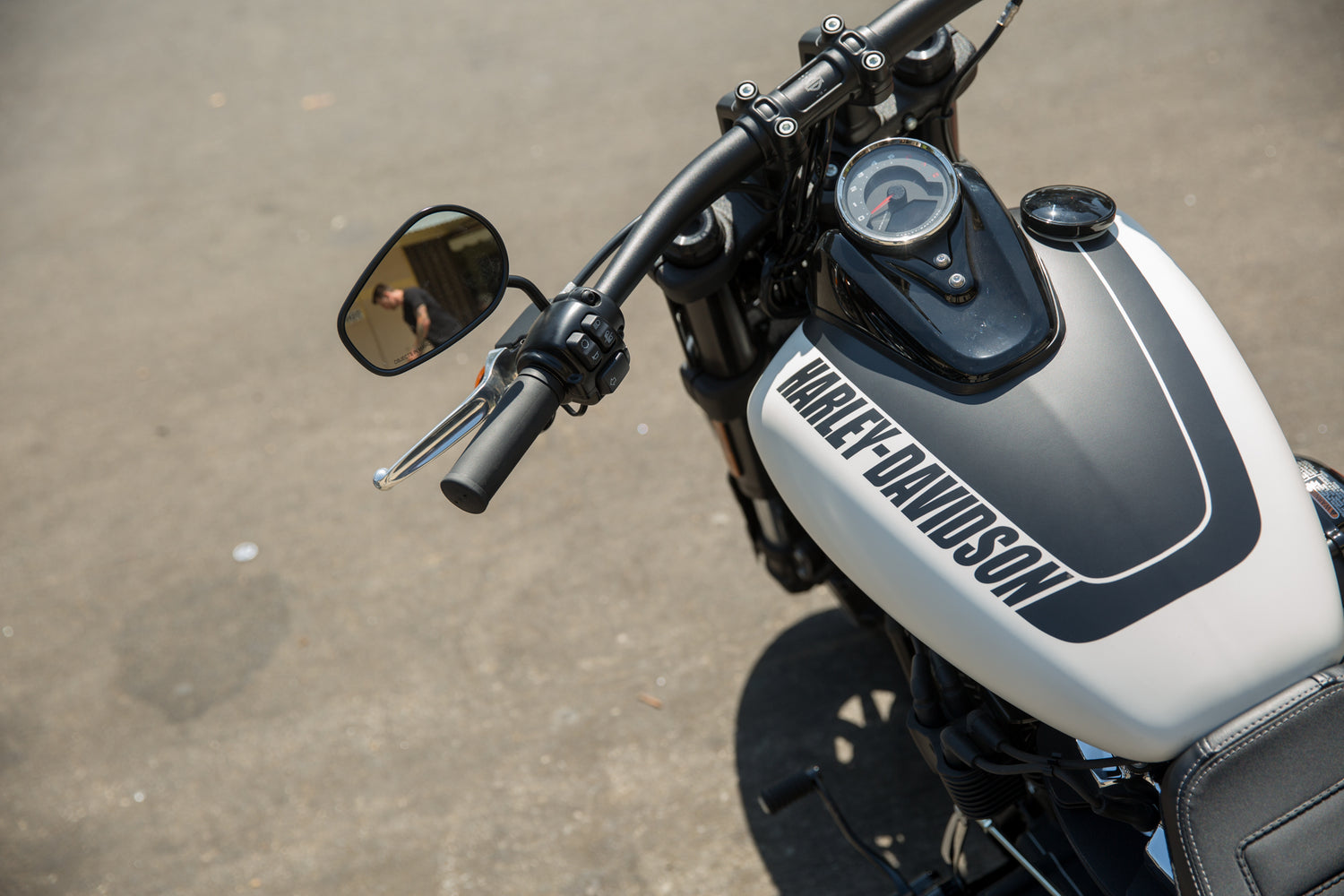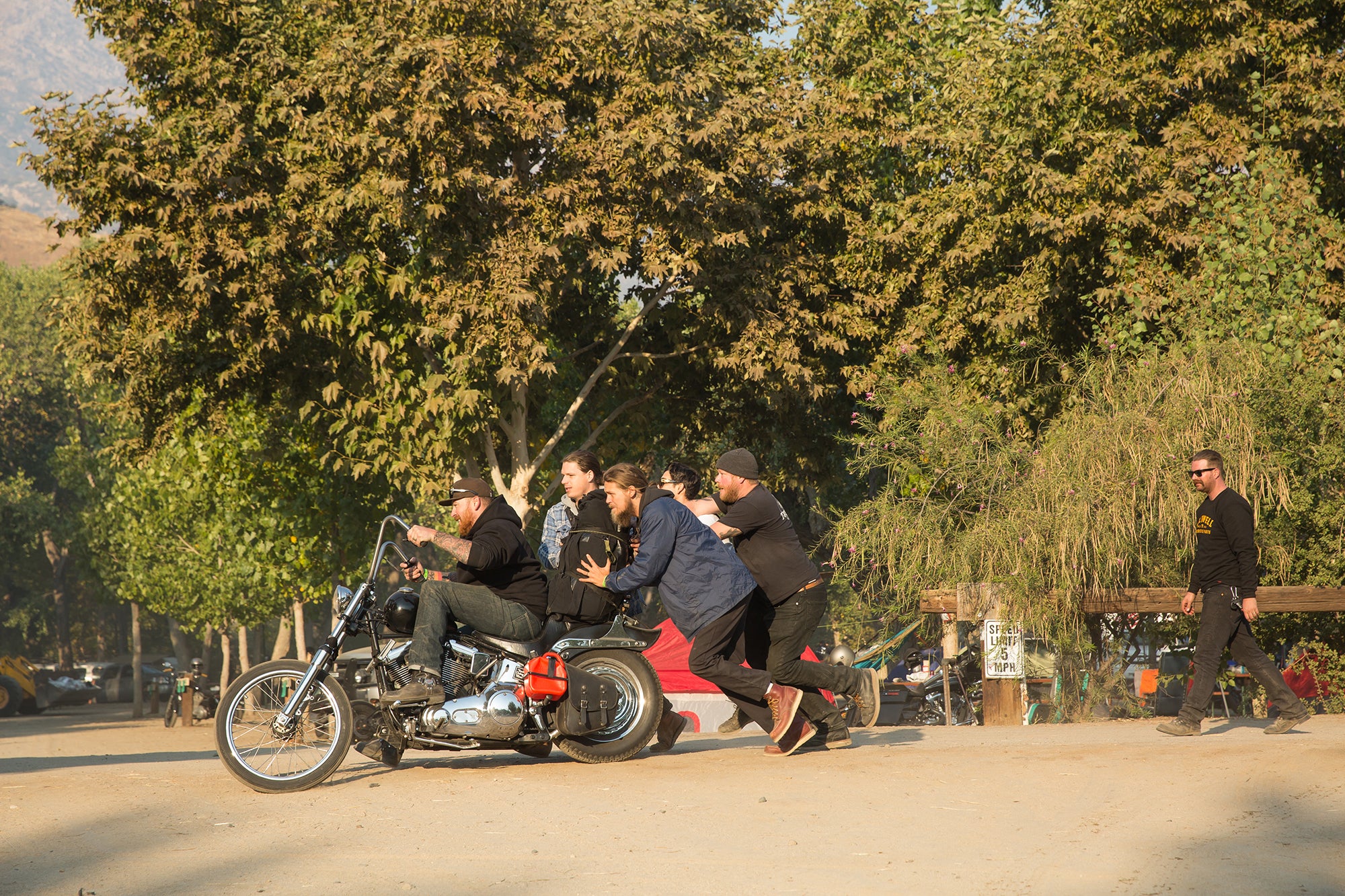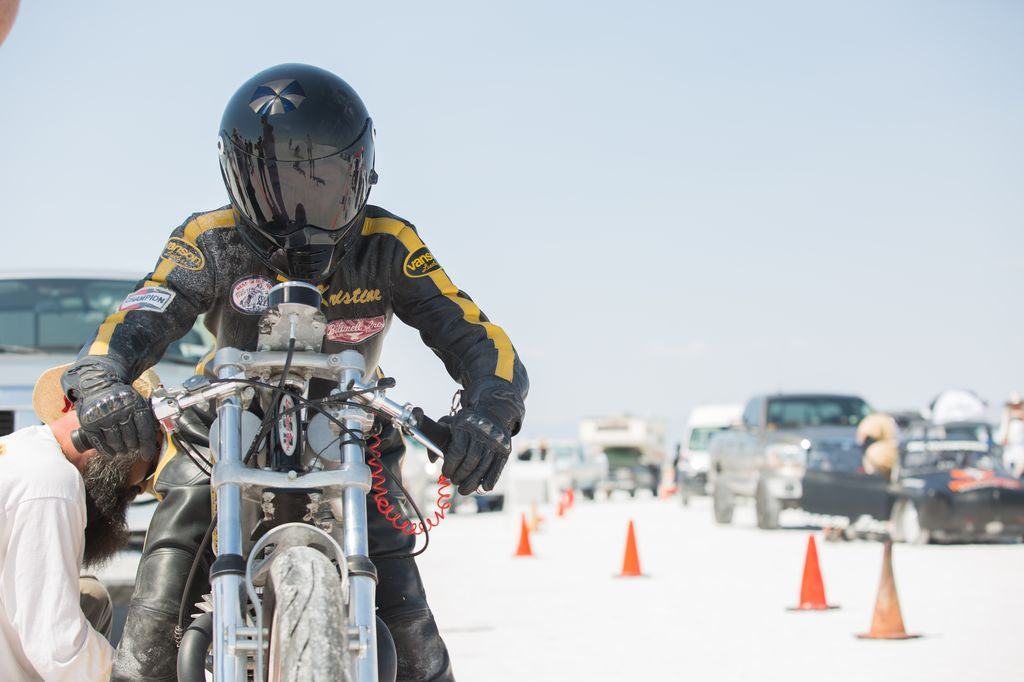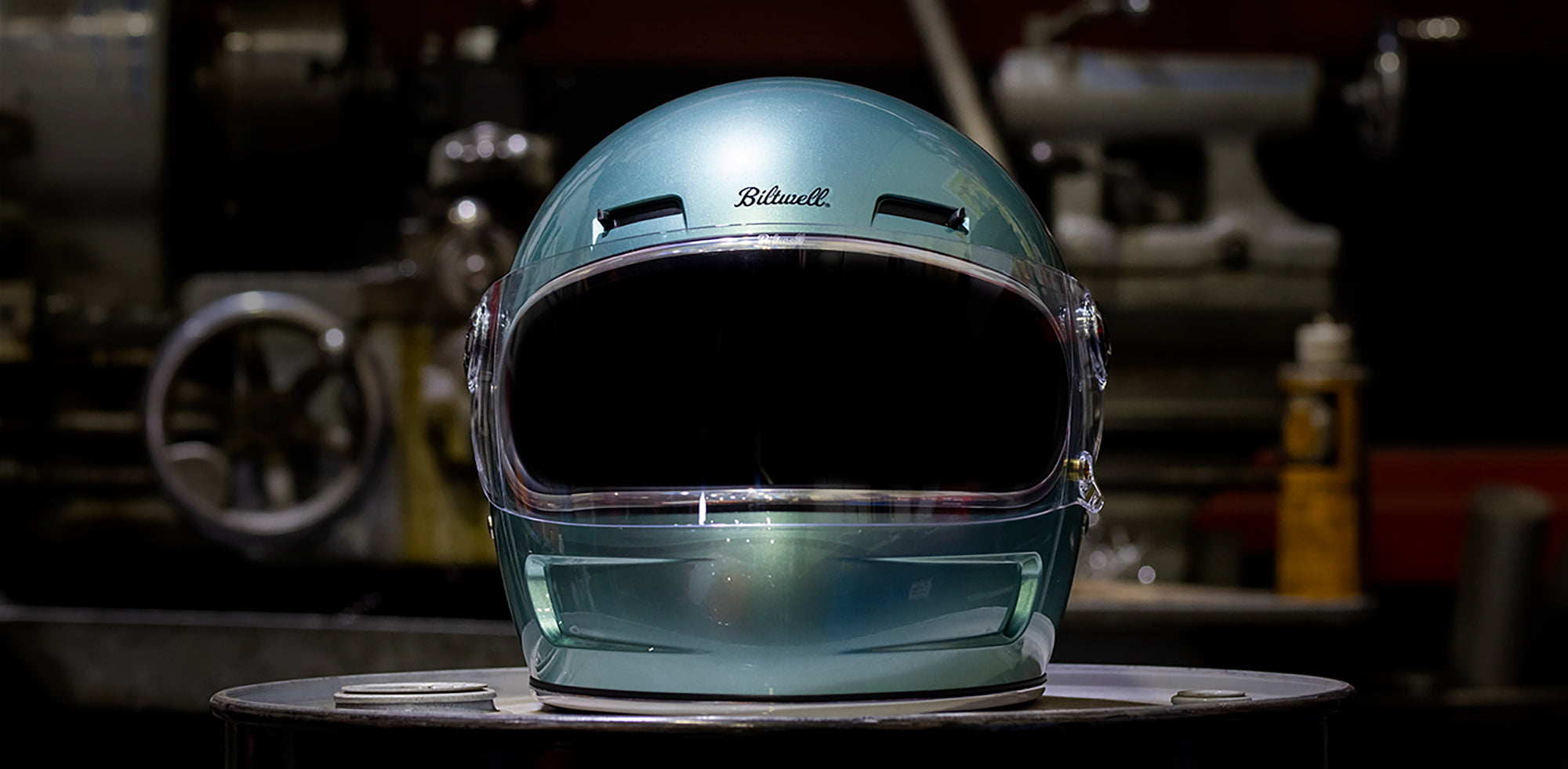Bold moves by the MoCo
 Harley-Davidson’s heritage—both distant and recent—has always been a double-edged sword. The design of their early big twin motorcycles has become what we naturally expect a motorcycle to look like, and for good reason: their overall shape and proportions seem just right. On the other hand, when Milwaukee makes a substantial move, the faithful freak out. This is the conundrum at Harley-Davidson with the latest iteration of their new-for-2018 Softail chassis. I for one applaud The Motor Company for tearing the Band-Aid off and dragging customers into this century, even if a few of them go kicking and screaming along the way.
Harley-Davidson’s heritage—both distant and recent—has always been a double-edged sword. The design of their early big twin motorcycles has become what we naturally expect a motorcycle to look like, and for good reason: their overall shape and proportions seem just right. On the other hand, when Milwaukee makes a substantial move, the faithful freak out. This is the conundrum at Harley-Davidson with the latest iteration of their new-for-2018 Softail chassis. I for one applaud The Motor Company for tearing the Band-Aid off and dragging customers into this century, even if a few of them go kicking and screaming along the way.
 Back when McGoo and I ran ChopCult, I always enjoyed working on the bike tests. I’m not a professional rider or writer by any means, so take this review with a drop of 50-weight. I’m used to riding a ’92 FXR or one of two shovelhead choppers in my personal stable, so my perspective may not be the same as yours. However, I’ve ridden thousands of miles on borrowed Dynas over the years so it’s not like I’m just regurgitating a press release here. I was never impressed enough with the Dynas or Softails to actually buy one. Of course, they are great motorcycles, but I’ve always felt like my FXR did everything I needed, and had more character. Basically, I’m a grumpy old man who is hard to please, and I don’t buy new motorcycles.
Back when McGoo and I ran ChopCult, I always enjoyed working on the bike tests. I’m not a professional rider or writer by any means, so take this review with a drop of 50-weight. I’m used to riding a ’92 FXR or one of two shovelhead choppers in my personal stable, so my perspective may not be the same as yours. However, I’ve ridden thousands of miles on borrowed Dynas over the years so it’s not like I’m just regurgitating a press release here. I was never impressed enough with the Dynas or Softails to actually buy one. Of course, they are great motorcycles, but I’ve always felt like my FXR did everything I needed, and had more character. Basically, I’m a grumpy old man who is hard to please, and I don’t buy new motorcycles.
RIDE, THEN DECIDE
Somehow, Otto sweet-talked our way into borrowing a couple of the new 2018 Softails from H-D one week after their debut. We didn’t get to take them for a two-week stint to the bottom of Baja and back like I’ve done for other reviews, but we did get to bang around my old stomping grounds in SoCal’s South Bay for a full day of riding. While not enough time to really dig deep, the rough roads and congested traffic on one of the hottest days of the year proved challenging enough for us get to know these bikes better. We traded off riding three different Softail models: Lowrider, Fat Bob and Street Bob. There are eight new bikes in the 2018 model line on this new chassis featuring a 107-inch Milwaukee 8 as the base power plant and a 114-inch engine option in four: The Fat Bob, Fat Boy, Breakout and Heritage Classic. In case you haven’t heard the news, these twelve models replace all previous Softails and eliminate the Dyna completely. WTF, you say? Yep. Harley is heavily invested in their Milwaukee 8 engine that launched with the 2017 touring bikes. Since that new engine didn’t fit in the old Dyna frame, something had to give. Might as well design a new chassis that’s lighter, stronger, faster and perhaps most importantly, more efficient to manufacture, right? Holding on to old designs just to keep the faithful happy might just be “hugging the baby to death.” Many of the faithful who don’t want change are also aging out of the motorcycle market at an alarming rate, and while we here at Biltwell have lots of young customers who ride Dynas, consolidating to a single platform to more efficiently meet declining demand was a pragmatic yet painful move for H-D.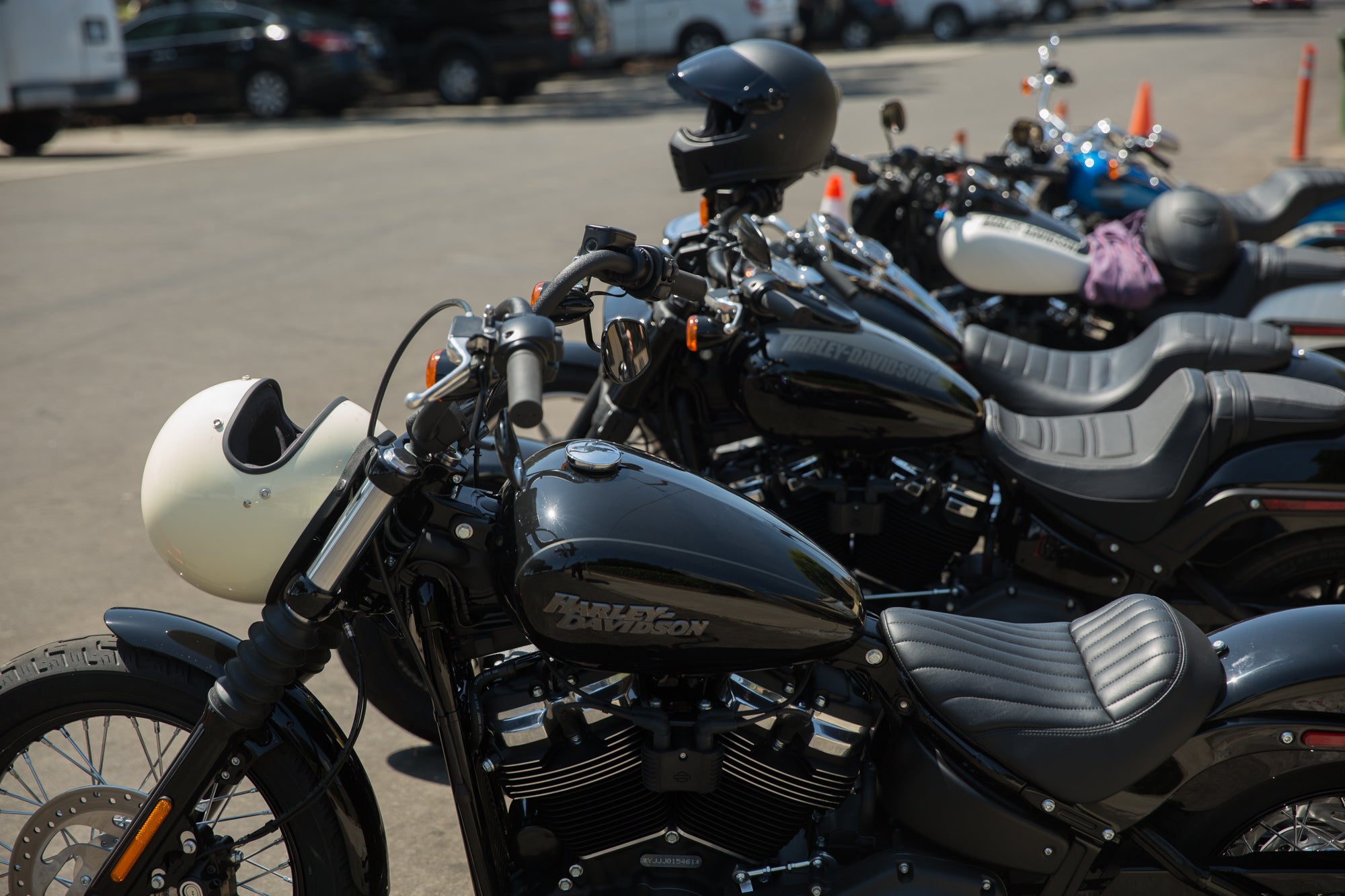
SOFTAIL IT IS NOT
I believe that choosing the Softail name was a mistake. It’s not the old Softail design at all, so it’s unfair to saddle this new machine with what some would consider negative equity. I don’t know a single Dyna enthusiast who is stoked on the name. At the end of the day, names are just marketing tools and don't affect riding enjoyment. For this review, I’ll start with the Street Bob since it’s the one I personally spent the most time on, and the one that seems to have received the least attention by the press and social media. Fake news! I picked this one because it’s “regular old Harley” aesthetics appealed to my grumpy old man sensibilities. I punished a FXDB for ChopCult back in 2009 so I figured I would have some context and familiarity with the model. The first thing that was immediately apparent were the ergonomics. According to Harley specs the new bike’s wheelbase is identical to the 2010, but overall length is shorter by 1.5” (fender overhang?) The steering angle is one degree quicker (30° compared to the old 29°) and trail has increased from 4.7 to 6.2. Resting seat height grew by one-tenth to 26.8 inches. Weight loss is a measly four pounds compared to the outgoing model. What is odd about these numbers is how much smaller and lighter the new bike feels. On paper, it’s virtually identical, but seat-of-the-pants data suggests the bike feels somehow magically scaled down and more nimble. Perhaps the new seating position, lovely slimmed-down primary, smaller ape handlebars and nicely-proportioned 3.5-gallon tank combine to create a lower center of gravity and more compact riding experience. Whatever it is, it rides and feels great.
The first thing that was immediately apparent were the ergonomics. According to Harley specs the new bike’s wheelbase is identical to the 2010, but overall length is shorter by 1.5” (fender overhang?) The steering angle is one degree quicker (30° compared to the old 29°) and trail has increased from 4.7 to 6.2. Resting seat height grew by one-tenth to 26.8 inches. Weight loss is a measly four pounds compared to the outgoing model. What is odd about these numbers is how much smaller and lighter the new bike feels. On paper, it’s virtually identical, but seat-of-the-pants data suggests the bike feels somehow magically scaled down and more nimble. Perhaps the new seating position, lovely slimmed-down primary, smaller ape handlebars and nicely-proportioned 3.5-gallon tank combine to create a lower center of gravity and more compact riding experience. Whatever it is, it rides and feels great.


SEATS AND FEETS
The seat on the 2018 Street Bob feels comfortable and looks great, but doesn’t have as much back support as the Fat Bob, or cushiness of the Lowrider. I strongly prefer mid-controls and this bike has them. They are slightly forward compared to mids of the 1970’s, but you sit lower so it makes sense. With my troll-sized 31-inch inseam, I could easily sit flat-footed at a stop light and the reduced bulk in the primary and low-profile air cleaner added to that comfort. Being able to stand up from time to time is important to me, and it was easy on this bike. Otto checks in at 6-foot-4 and he rode the Street Bob, too. Frankly, we were surprised how comfortable he was on it, and that could be fine-tuned with bar/riser/seat modifications. If you’re a big dude and like to stretch out, you’ll probably be more comfortable on the models equipped with forward controls, like the Lowrider.
FIRE IN THE HOLE
How about that 107-inch Milwaukee 8? Harley numbers show that the 2010 Street Bob generated 92 ft. lb. of torque; this new model weighs in at 110 pounds of twist. What the seat of my pants told me is that this thing hauls ass, but in a very composed fashion. The 114-inch M8 Otto rode most of the day was slightly faster, but we were pretty evenly matched jamming from light to light, so I wouldn’t call the smaller 107 a slouch by any means. Stock exhaust sound (or lack thereof) might make friends out of neighbors but it’ll probably be the first thing that gets changed by a new buyer. It doesn’t sound bad by any means, but like all OE exhaust systems, it’s just quieter and more subdued than I prefer. Squirting through traffic or gaining elevation to circumnavigate the Palos Verdes peninsula, I never once considered the fact that I might need more power. On SoCal freeways and backroads, the output was more than adequate while still easy to handle.
MORE ON THAT NEW CHASSIS
I’ve never been a fan of the old Softail. I didn’t mind looking at them, but I never cared much for riding them. The counter balanced engine and lack of travel in the rear suspension just felt too far from what I’m used to. This is not your dad’s Softail. According to Harley this new frame is substantially less flexible and it feels and it rides like it. Jamming through tight corners and over pot holes brings out the flex and squeaks in any chassis, and I purposely put the FXBB through the worst conditions I could find. I don’t mind if a bike has shortcomings, hell, I ride choppers. What I want in a motorcycle is predictability. I know how my rigid shovelheads perform even if that performance is way behind a modern bike. What matters to me is that it tracks consistently and that there are no surprises. This Softail checks those boxes with very predictable handling and none of that rear end swagger that the old Dyna was cursed with.WHAT ABOUT THE FAT BOB
The polarizing styling of this bike is probably what lit the internet on fire last week after the black box reveal on social media. While no one at Biltwell is a fan of the feet forward/beach bar riding position, that could be tweaked by an easy handlebar change. Unfortunately, on this model the bars are huge tapered tube units with a 1-1/4-inch clamp area that only fits these risers. This is neat if you want to keep it stock, but a bit of a challenge for the aftermarket. After acknowledging this home customizer’s headache, let’s talk about the homeruns. The Fat Bob’s seat is fantastic. The gripper material is contemporary, the shape complements the geometry of the bike and it also happens to be comfortable, with plenty of backstop to keep you in the pocket when you get on the stinker. The inverted front end is high-tech for a Harley, the 4-piston dual disc front brakes are outstanding and the weight is down from 706 pounds to a svelte 673. Handling characteristics are substantially more rigid than either the previous Softail or Dyna, and are better than any stock big twin I’ve ever ridden. The rear shock preload adjuster does something when you adjust it, so riders who add passengers or gear will enjoy trying to find the sweet spot with that device. Of course, adjustable damping would be nice too, but at least Harley is marching in the right direction.

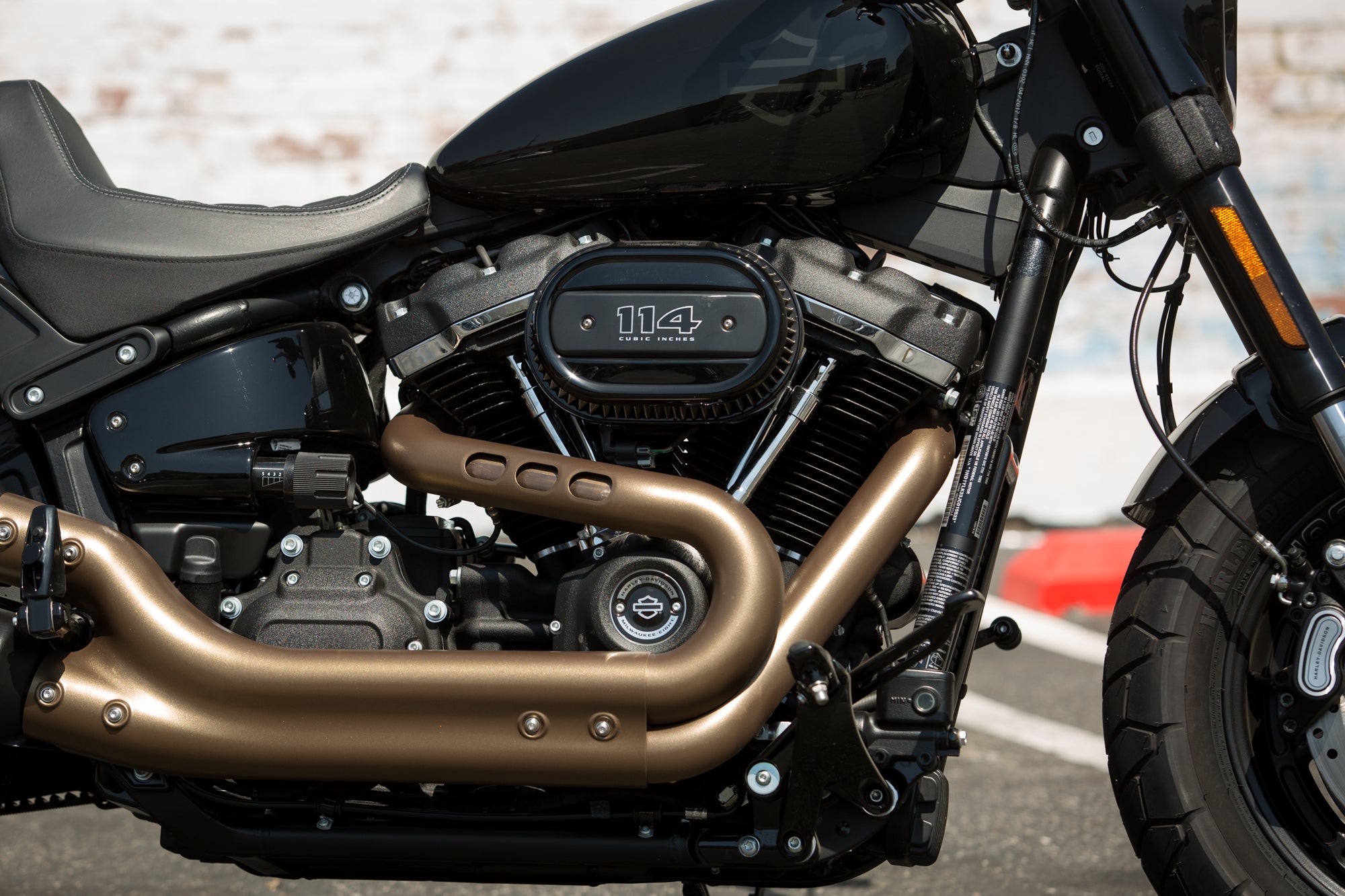
OTTO AND THE FAT BOB So, this bike was super nimble in traffic around town, more than competent in the twisties, and real fun jamming down PCH, but how would it be on the freeway? I got a chance to find out when we headed back to HD HQ on the 405 North. If you’ve ever ridden this section of SoCal slab, you know it sucks! Potholes, rain grooves and years of haphazard repairs coupled with the angry commuters that fight it out every day make this one of the more treacherous stretches of roads in SoCal, but the Fat Bob handled it with ease. I got onto the freeway effortlessly, merged into the fast lane effortlessly and once I could do so, I cracked throttle-by-wire wide open and waited to feel what the road told my bike. I was surprised the uneven tarmac felt smooth and fast, my back reaffirming this initial assessment. I liked how when traffic appeared in the horizon, the ABS brakes drew the bike to a safe speed effectively and I really liked how nimble and light the #freedommachine felt when splitting lanes, as is inevitably the scenario whenever running the gauntlet of highways and byways in the land of sun and sand.


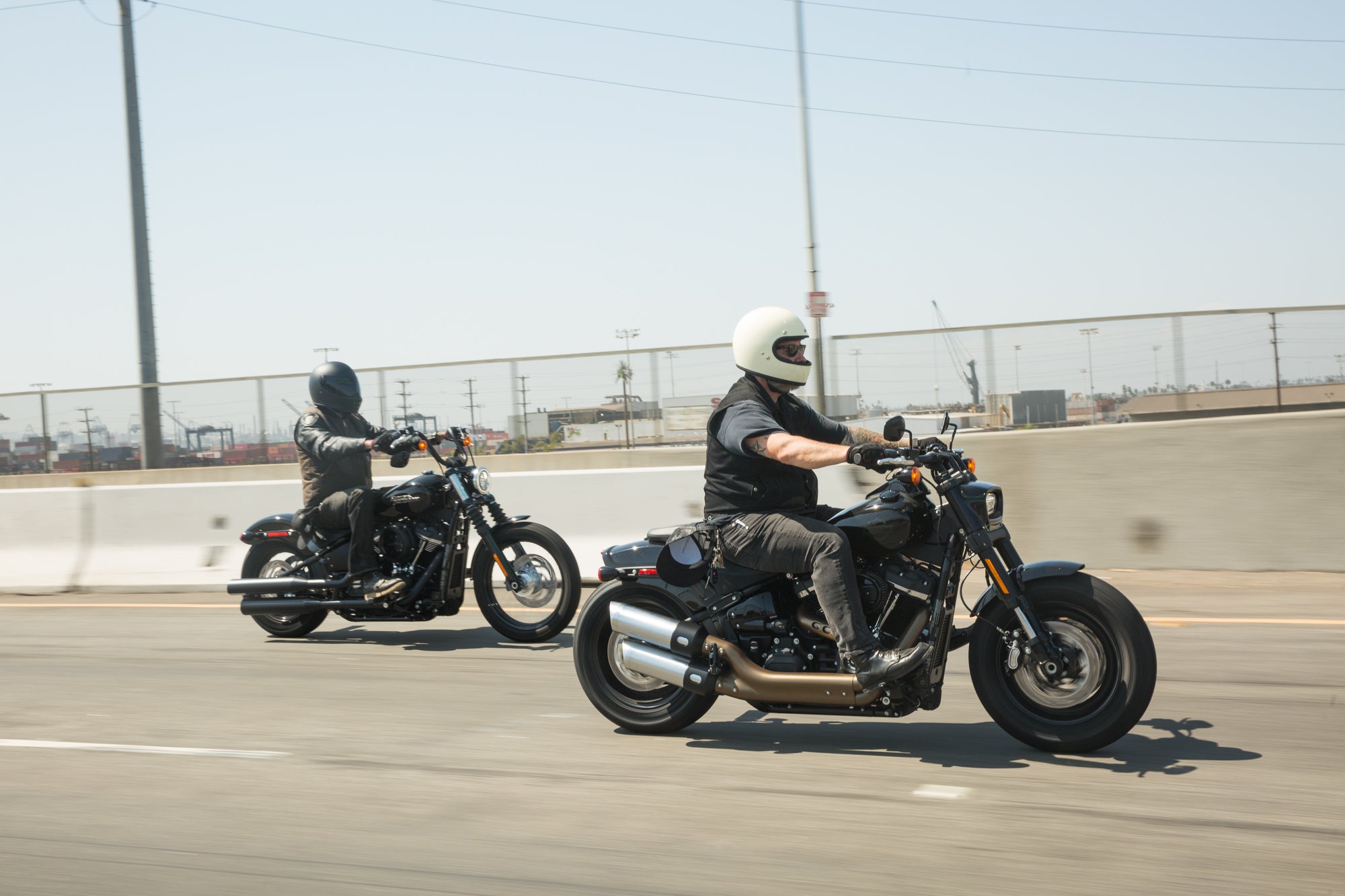 Press photos of the Fat Bob left me a little puzzled when I watched the unveiling last week. Seeing the bike in the wild and riding it changed my mind about the controversial styling. That 3/4 rear view when the bike is curbed up in front of the bar and you’re looking at it from behind is perfect. The stance is taut, the huge fender gap looks racy, and the beefy 16-inch wheels and asymmetrical muscle car paint look tough as nails. I expected to dislike this model, but I don’t. It feels like the Fat Bob would be the natural choice for the Dyna stunt guys since it’s such a performance-oriented machine, but with the forward controls and wacky bar set up, it’ll take some mods to get it right. I doubt a 16-inch solid front wheel would be the choice for that rider either, so it’s probably more logical that they’ll start with the Lowrider and modify that into the new version of the “Club Style” bike. I would love to see this model with a 19/17 F/R wheel combo and mid foot controls. As bulky as the 16-inch front wheel looks, it tracks nicely and doesn’t feel anywhere near as heavy as its looks imply.
Press photos of the Fat Bob left me a little puzzled when I watched the unveiling last week. Seeing the bike in the wild and riding it changed my mind about the controversial styling. That 3/4 rear view when the bike is curbed up in front of the bar and you’re looking at it from behind is perfect. The stance is taut, the huge fender gap looks racy, and the beefy 16-inch wheels and asymmetrical muscle car paint look tough as nails. I expected to dislike this model, but I don’t. It feels like the Fat Bob would be the natural choice for the Dyna stunt guys since it’s such a performance-oriented machine, but with the forward controls and wacky bar set up, it’ll take some mods to get it right. I doubt a 16-inch solid front wheel would be the choice for that rider either, so it’s probably more logical that they’ll start with the Lowrider and modify that into the new version of the “Club Style” bike. I would love to see this model with a 19/17 F/R wheel combo and mid foot controls. As bulky as the 16-inch front wheel looks, it tracks nicely and doesn’t feel anywhere near as heavy as its looks imply.




THE LOWRIDER
I didn’t spend much time on the Lowrider even though I expect it’ll be a brisk seller since it’s the most conventional bike of the lot. I was shocked when I hoped on this bike and took off down the rutted 710 out of Long Beach Harbor. If I closed my eyes, I’d swear I was on my old stock 1971 FLH, but less janky and way more powerful. And with brakes that work. The riding position felt exactly like that old bike, which is something I wasn’t expecting. The buckhorn bars won’t be everyone’s cup of tea, but that is an easy swap on this bike with traditional risers and the gauges on the tank. The seat was plusher and I could tell the seat height is about a half inch taller so you sit slightly more on top of the bike, rather than down in it like the Street Bob. If you want a Harley-Davidson that proudly looks like a regular old Harley-Davidson, it would be hard to find a better choice.
 Caught between millennials who don’t ride and grumpy old guys that hate change, the MoCo has made bold moves with this dramatic new chassis. The design and engineering teams have created a model line with eight very distinctly different motorcycles that are not just hanging different decorations on the same old tree. Through subtle tweaking of suspension bits, gauges, geometry and ergonomics, the three machines we rode were each very much unique. We didn’t even try the models that push the envelope further, like the Fat Boy or Heritage Classic. This is a smart and calculated decision that might be what it takes to set the tone for the next decade or two and help this classic American brand survive in an age of driverless cars and internet hysteria. Now only one question remains: what’s going to happen to the Sportster in 2019? -Bill
Read a more in-depth story on this subject by our friend Ed:
http://www.hotbikeweb.com/2018-harley-davidson-softail-makes-once-great-dyna-irrelevant
See the bikes on H-D's site here:
https://motorcycles.harley-davidson.com/us/en/2018/index.html
Caught between millennials who don’t ride and grumpy old guys that hate change, the MoCo has made bold moves with this dramatic new chassis. The design and engineering teams have created a model line with eight very distinctly different motorcycles that are not just hanging different decorations on the same old tree. Through subtle tweaking of suspension bits, gauges, geometry and ergonomics, the three machines we rode were each very much unique. We didn’t even try the models that push the envelope further, like the Fat Boy or Heritage Classic. This is a smart and calculated decision that might be what it takes to set the tone for the next decade or two and help this classic American brand survive in an age of driverless cars and internet hysteria. Now only one question remains: what’s going to happen to the Sportster in 2019? -Bill
Read a more in-depth story on this subject by our friend Ed:
http://www.hotbikeweb.com/2018-harley-davidson-softail-makes-once-great-dyna-irrelevant
See the bikes on H-D's site here:
https://motorcycles.harley-davidson.com/us/en/2018/index.html



 Shop All Helmets
Shop All Helmets Shop All Optics
Shop All Optics Shop All Accessories
Shop All Accessories Shop All Gloves
Shop All Gloves Shop All Luggage
Shop All Luggage Shop All Apparel
Shop All Apparel Shop All Etc.
Shop All Etc. Outlet
Outlet WTF Blog
WTF Blog